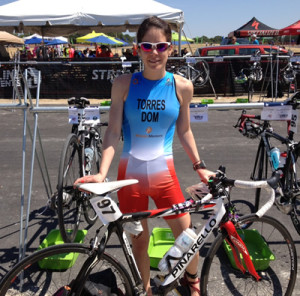Make Your Warm Up Count
November 24th, 2013 by Roxane Kippen, USA Triathlon Certified CoachUnfinished Business: How to Become a Comeback Kid
November 15th, 2013 by tritter Many adult athletes can trace their sporting start to a younger, simpler time when life’s responsibilities had yet to compete and consume their schedule. Dominican-born triathlete Raquel Tavares-Torres was one such promising young athlete whose athletic achievements would be sidelined in her prime by study, marriage, and raising a family. Sixteen years later, with great coaching and a supportive family, Tavares-Torres has become the ultimate comeback kid.
Many adult athletes can trace their sporting start to a younger, simpler time when life’s responsibilities had yet to compete and consume their schedule. Dominican-born triathlete Raquel Tavares-Torres was one such promising young athlete whose athletic achievements would be sidelined in her prime by study, marriage, and raising a family. Sixteen years later, with great coaching and a supportive family, Tavares-Torres has become the ultimate comeback kid.
Tavares-Torres took up swimming at the age of 3, and competition by the age of 5. She started mountain bike riding and racing around the age of 12 and then combined these abilities with running when she started triathlons two years later. She continued to develop in multisport through a local club, and at 16 took 1st in the Junior Pan American games. Though she loved the sport, she had turned her focus towards getting her degrees, first an undergrad, then a masters, and finally an MBA. Along the way, she married and had a daughter.
Fast forward 15 years to 2012 when Tavares-Torres’ husband suggested she try competing again by doing a local Grand Rapids triathlon. With a bike purchase in hand, she signed up for an Olympic distance event. With three weeks of training, and just a few rides on her new steed, Tavares-Torres took a remarkable 2nd. A few weeks later she took 1st overall at the Michigan Championships. The fire had been lit.
Tavares-Torres joined a local tri club, and decided to get some VO2 testing done at Athletic Mentor partner, In The Zone, where she set the record for the highest results they’d ever recorded. Her home country, Dominican Republic, wanted her to turn elite. She’d confirmed she had the talent, but knew she lacked direction. In February of ’13, Tavares-Torres started working with Athletic Mentors’ coach Mark Olson.
At first Tavares-Torres wasn’t sure. “I didn’t think I was training enough, but kept seeing improvement from race to race,” she said. “I decided to just trust Mark.”
Tavares-Torres also appreciates the tools AM uses, like Training Peaks.
“I love to be organized, and then talk to Mark if I need to change things,” she said. Olson used these tools to address Tavares-Torres biggest weakness, the bike. After some dedicated base building on two wheels, things started to come together.
“I felt better on the bike and also the run,” she said. It became apparent she was on the right track. “I think Mark knows what he’s doing.”
Tavares-Torres is now focusing on her longer team goals. She wants to see how far she can take this sport, and for the top ranked Dominique Republic female pro triathlete, that means representing her home country by qualifying for the 2016 Olympics in Rio De Janerio. Along that path is the Chicago ITU World Cup in June of 2014.
With a goal in mind and the support of her family, home federation, and coach, Tavares-Torres is again prioritizing the sport she left as a youth. She wants to give it her best, leaving no unfinished business.




 Our Hockey Site
Our Hockey Site Team AM
Team AM

